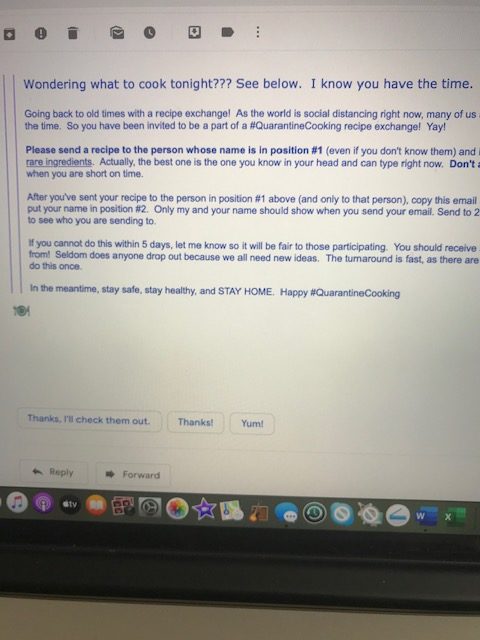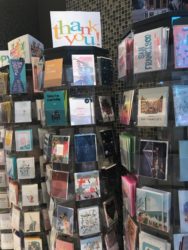
In a recent two-week period, I received six chain letter invitations. Other than one overlap, each was from a person unrelated to the others. Three of them were called “Quarantine Recipes.” The other three, in various forms, were about passing along an inspirational quote, poem, thought, or song. Each is structured in a short pyramid, e.g. send the requested item to the person at the top of the list, remove their name, add your name to the bottom, and repeat the request to 10 (or 20) additional, hopefully receptive, people.
Something is afoot, because each of these email requests came from good friends, people I care about, who would not normally share or forward a chain letter. A few of these letters come with disclaimers, such as “I don’t ordinarily do chain letters, but…” Others start with an appeal to inspiration, using phrases such as “join us for a constructive and uplifting exchange.”
However, in my experience, chain letters lose their appeal after one or more rounds of participation. As one friend aptly stated, “No matter the intentions, I dislike chain emails. Usually, I let the sender know. They are always broken. I remember, in my preteen years, chain letters – real ones! On paper and in an envelope! I don’t see the point of them.”

So why are people sending out these emails? Though it is unknown how or why this new wave of chain letters originated, it has definitely become viral. Perhaps it is a way of feeling connected, especially during this time of semi-quarantine during an unprecedented pandemic. While sheltering in place, with our restaurants, shops, salons, and other meeting places closed, we feel a need to remind people that we care about them. As one of these letters concludes, “let us practice physical distancing, not social distancing.”
For the most part, even if we prefer not to participate in chain letters, we want to support the person who sent the message. And conceptually, the ideas are not only well-intended but also, for the most part, harmless. What could go wrong by sharing a recipe? Why not “spread some beauty through the world in these difficult times?” by sharing a poem or inspirational thought? And, as one letter stated, “we all need a bright spot in our days, especially now.”
Yet there are potential downsides to chain letters. Your contact information likely will be shared with people you do not know. Much is based on trust and good intentions.
One of my cousins noted that she does not participate in chain letters because “no one responds, so I stopped doing them. It’s a great idea only if everyone participates.” Another friend, who sent me a chain letter, flatly stated “I hate them!”
I confess to being one of the guilty parties, one who does not pass along chain letters. Recently, however, just this once, I did send along one of those Quarantine Recipe email chain letters. About one third of the recipients wrote back to say “thanks, but no thanks.” I received no response from the others, but was truly surprised to receive four new recipes via email. Clearly, some people do respond. None of these contributors were familiar to me, so I do not know which people “did not break the chain.”
The very earliest form of chain letters likely dated back to the Middle Ages, and were shared with the purpose of spreading religious messages, according to the fact-checking site Snopes. Secular chain letters appeared in the U.S. after 1900, often with the motive of making money. Daniel W. VanArsdale, an independent researcher and authority on chain letters, has compiled an archive and history of chain letters, with examples dating back to 1888. The archive also explains how chain letters work.
Chain letters have a somewhat rocky history. As with any pyramid scheme, there will be winners and losers when chain letters ask for a small donation and promise riches in return. Such letters today are illegal. Good luck chain letters are another genre, promising good luck to those who distributed the message and bad luck if not.
One of my friends, to whom I sent the Quarantine Recipes email, responded on Facebook, to me and most likely to others. “I love you, but please don’t add me to your recipe chain letter. (But feel free to send me a favorite recipe of yours!).”
Okay. Lesson learned (again). I promise not to send another chain letter.
SOURCES
Chain Letter. Wikipedia
Chain Letter Evolution by Daniel W. VanArsdale (online archive)
Chain Letters: A Discussion of the History and Various Types of Chain Letters by David Mikkelson. Snopes
Remember Chain Emails? They’re Back! By AJ Willingham. CNN, April 16, 2020
You Must Forward This Letter to Five Friends: The Curious History of Chain Letters by Paul Collins. Slate, Oct. 1, 2010




